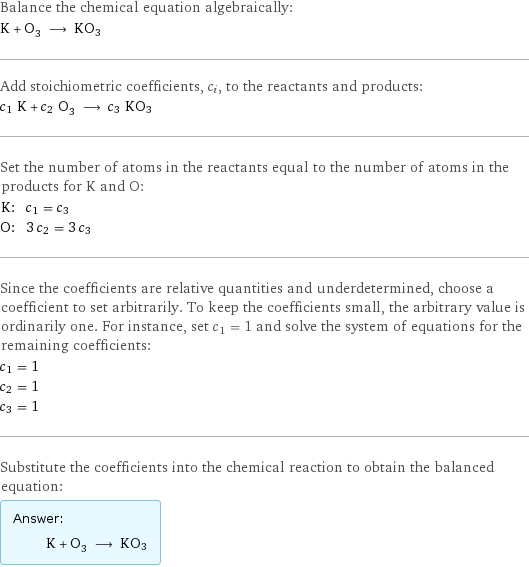Input interpretation

K potassium + O_3 ozone ⟶ KO3
Balanced equation

Balance the chemical equation algebraically: K + O_3 ⟶ KO3 Add stoichiometric coefficients, c_i, to the reactants and products: c_1 K + c_2 O_3 ⟶ c_3 KO3 Set the number of atoms in the reactants equal to the number of atoms in the products for K and O: K: | c_1 = c_3 O: | 3 c_2 = 3 c_3 Since the coefficients are relative quantities and underdetermined, choose a coefficient to set arbitrarily. To keep the coefficients small, the arbitrary value is ordinarily one. For instance, set c_1 = 1 and solve the system of equations for the remaining coefficients: c_1 = 1 c_2 = 1 c_3 = 1 Substitute the coefficients into the chemical reaction to obtain the balanced equation: Answer: | | K + O_3 ⟶ KO3
Structures

+ ⟶ KO3
Names

potassium + ozone ⟶ KO3
Equilibrium constant
![Construct the equilibrium constant, K, expression for: K + O_3 ⟶ KO3 Plan: • Balance the chemical equation. • Determine the stoichiometric numbers. • Assemble the activity expression for each chemical species. • Use the activity expressions to build the equilibrium constant expression. Write the balanced chemical equation: K + O_3 ⟶ KO3 Assign stoichiometric numbers, ν_i, using the stoichiometric coefficients, c_i, from the balanced chemical equation in the following manner: ν_i = -c_i for reactants and ν_i = c_i for products: chemical species | c_i | ν_i K | 1 | -1 O_3 | 1 | -1 KO3 | 1 | 1 Assemble the activity expressions accounting for the state of matter and ν_i: chemical species | c_i | ν_i | activity expression K | 1 | -1 | ([K])^(-1) O_3 | 1 | -1 | ([O3])^(-1) KO3 | 1 | 1 | [KO3] The equilibrium constant symbol in the concentration basis is: K_c Mulitply the activity expressions to arrive at the K_c expression: Answer: | | K_c = ([K])^(-1) ([O3])^(-1) [KO3] = ([KO3])/([K] [O3])](../image_source/07e265be4580e9e60d3d3268a23688eb.png)
Construct the equilibrium constant, K, expression for: K + O_3 ⟶ KO3 Plan: • Balance the chemical equation. • Determine the stoichiometric numbers. • Assemble the activity expression for each chemical species. • Use the activity expressions to build the equilibrium constant expression. Write the balanced chemical equation: K + O_3 ⟶ KO3 Assign stoichiometric numbers, ν_i, using the stoichiometric coefficients, c_i, from the balanced chemical equation in the following manner: ν_i = -c_i for reactants and ν_i = c_i for products: chemical species | c_i | ν_i K | 1 | -1 O_3 | 1 | -1 KO3 | 1 | 1 Assemble the activity expressions accounting for the state of matter and ν_i: chemical species | c_i | ν_i | activity expression K | 1 | -1 | ([K])^(-1) O_3 | 1 | -1 | ([O3])^(-1) KO3 | 1 | 1 | [KO3] The equilibrium constant symbol in the concentration basis is: K_c Mulitply the activity expressions to arrive at the K_c expression: Answer: | | K_c = ([K])^(-1) ([O3])^(-1) [KO3] = ([KO3])/([K] [O3])
Rate of reaction
![Construct the rate of reaction expression for: K + O_3 ⟶ KO3 Plan: • Balance the chemical equation. • Determine the stoichiometric numbers. • Assemble the rate term for each chemical species. • Write the rate of reaction expression. Write the balanced chemical equation: K + O_3 ⟶ KO3 Assign stoichiometric numbers, ν_i, using the stoichiometric coefficients, c_i, from the balanced chemical equation in the following manner: ν_i = -c_i for reactants and ν_i = c_i for products: chemical species | c_i | ν_i K | 1 | -1 O_3 | 1 | -1 KO3 | 1 | 1 The rate term for each chemical species, B_i, is 1/ν_i(Δ[B_i])/(Δt) where [B_i] is the amount concentration and t is time: chemical species | c_i | ν_i | rate term K | 1 | -1 | -(Δ[K])/(Δt) O_3 | 1 | -1 | -(Δ[O3])/(Δt) KO3 | 1 | 1 | (Δ[KO3])/(Δt) (for infinitesimal rate of change, replace Δ with d) Set the rate terms equal to each other to arrive at the rate expression: Answer: | | rate = -(Δ[K])/(Δt) = -(Δ[O3])/(Δt) = (Δ[KO3])/(Δt) (assuming constant volume and no accumulation of intermediates or side products)](../image_source/fe99d5e0a8df01bc1f098c0d08534a60.png)
Construct the rate of reaction expression for: K + O_3 ⟶ KO3 Plan: • Balance the chemical equation. • Determine the stoichiometric numbers. • Assemble the rate term for each chemical species. • Write the rate of reaction expression. Write the balanced chemical equation: K + O_3 ⟶ KO3 Assign stoichiometric numbers, ν_i, using the stoichiometric coefficients, c_i, from the balanced chemical equation in the following manner: ν_i = -c_i for reactants and ν_i = c_i for products: chemical species | c_i | ν_i K | 1 | -1 O_3 | 1 | -1 KO3 | 1 | 1 The rate term for each chemical species, B_i, is 1/ν_i(Δ[B_i])/(Δt) where [B_i] is the amount concentration and t is time: chemical species | c_i | ν_i | rate term K | 1 | -1 | -(Δ[K])/(Δt) O_3 | 1 | -1 | -(Δ[O3])/(Δt) KO3 | 1 | 1 | (Δ[KO3])/(Δt) (for infinitesimal rate of change, replace Δ with d) Set the rate terms equal to each other to arrive at the rate expression: Answer: | | rate = -(Δ[K])/(Δt) = -(Δ[O3])/(Δt) = (Δ[KO3])/(Δt) (assuming constant volume and no accumulation of intermediates or side products)
Chemical names and formulas

| potassium | ozone | KO3 formula | K | O_3 | KO3 name | potassium | ozone |
Substance properties

| potassium | ozone | KO3 molar mass | 39.0983 g/mol | 47.997 g/mol | 87.095 g/mol phase | solid (at STP) | gas (at STP) | melting point | 64 °C | -192.2 °C | boiling point | 760 °C | -111.9 °C | density | 0.86 g/cm^3 | 0.001962 g/cm^3 (at 25 °C) | solubility in water | reacts | |
Units
